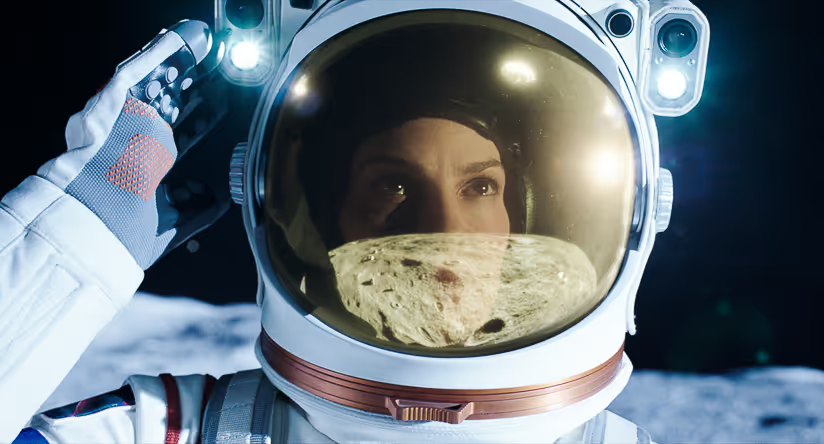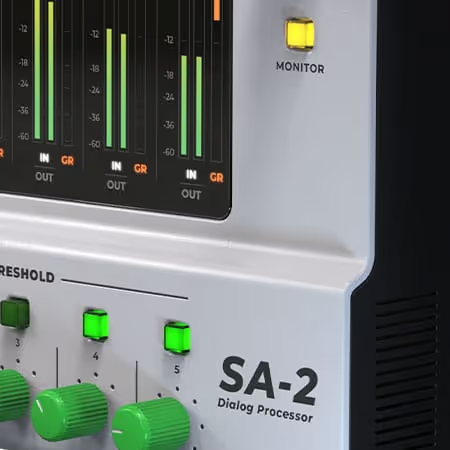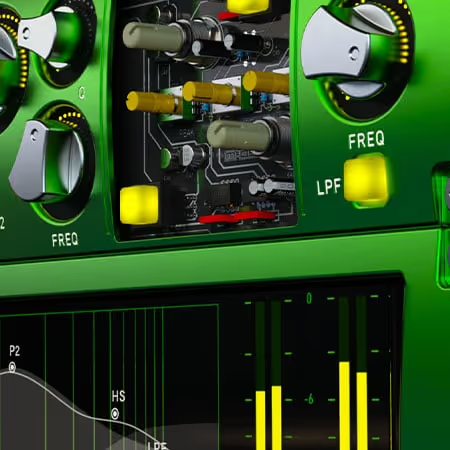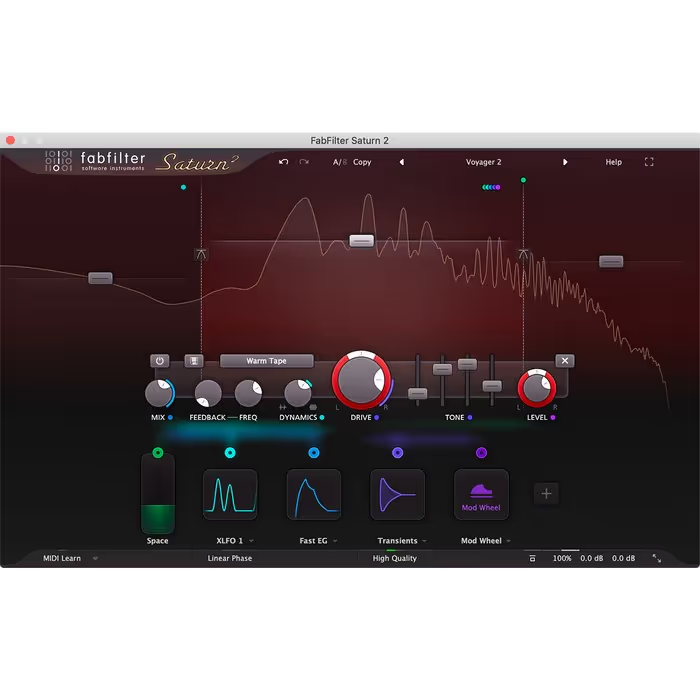Sending a crewed mission to Mars seems more possible with each passing day. What tolls would the long trip take on the crew? What perils could they face in space, isolated from assistance on Earth? Netflix’s new series Away explores the potential physical and emotional impacts of long-distance space travel in a realistic (non-sci-fi) sort of way.
Sound designer/re-recording mixer Jon Greasley and re-recording mixer Greg King of King Soundworks brought the mission to life by making the environment inside the space capsule feel like a living machine. Life support systems, like water filtration and air ventilation, clatter and tick behind the walls. They use the Atmos surround field to immerse the viewer in the crews’ experience. In contrast, the sound team chose to be more constrained with their mix of the sounds on Earth, pulling sounds out of the Atmos surround field.
Here, King and Greasley discuss this approach to mixing and other ways they used sound — like applying IRs from various sized metal containers and using extreme EQ processing for the spacewalk sounds — to create a realistic, believable trip to Mars for Away.
Away | Official Trailer | Netflix
You’ve gone from the Cosmos: Possible Worlds docu-series — where you created sound for these abstract and mind-blowing scientific theories and facts — to the more practical, tactile, tangible view of space in Netflix’s Away series. How do these two experiences of creating sound for space compare to each other?
Greg King (GK): It was different and the same in a sense.
Cosmos was all reality; it was about showing the world and the cosmos in a way that not very many people get to see. So we had to create this world, this environment that was fantastical but still felt real and organic.
Although we wanted to help the story and the wonder of space, we still had to keep it within the realm of the plausible…
The same is kind of true for Away, in the sense that, although it’s a fictional series, it’s plausible. It’s quite likely that NASA or some variation thereof will be doing a manned mission to Mars in the relatively near future.
Although we wanted to help the story and the wonder of space, we still had to keep it within the realm of the plausible and had to treat it in a realistic fashion. We never crossed over into a purely science fiction world. We tried to be grounded in reality — authentic and possible. The approach we took going into the series was with that in mind.
Jon Greasley (JG): As Greg said, both approaches were within the realm of possibility. With Cosmos, it was a bit more fantastical because the imagery would take us inside, for example, the nucleus of an atom. That is a real thing but no one is ever going to experience what that sounds like.
Whereas with Away, it didn’t feel futuristic — to me it’s like the show is set in an alternate present, one where we collectively decided to invest in our future and exploration rather than wars of choice, for example. From the set design to the concepts, everything was completely conceivable within our lifetimes. It needed to sound like tech that you could believe would be on a ship that Space X might build a decade from now or something like that.

There are so many great references and ideas of what space should/could sound like. What were some of your inspirations when deciding how outer space in Away should sound? What’s unique about your version of how space travel can sound?
GK: Globally, we wanted the ship to be a character because they’re on the ship for a long time. They’re traveling to Mars and it takes several months. We didn’t want the ship to be just a place; we wanted it to be one of the characters in the story.
We made the decision early on to have a lot of mechanical things in the ship. There was going to be physical mechanisms rather than everything being digital and on the circuit board. We wanted to imagine in our minds a ship that had a lot of mechanical things in it, like gyros and mechanisms roaring and starting up. So that while there is a scene going on with dialogue and storytelling, the ship could still be this living, breathing thing in the background to constantly keep you aware of the fact that you are moving through space and that, more importantly, their lives were held in the balance, reliant on this ship operating properly.
We wanted the audience to feel the ship and hear it working.
When you’re watching the show, or any space show, you take for granted that the travelers are going to be safe and sound. But we never wanted the audience to be off the hook like that. We wanted the audience to always be aware that this is something that could fail. They even address failures in a multiple-episode arc on the show when the water system failed. Failures can happen and they can be life-threatening.
We didn’t want any instances of failures on the ship to be a surprise, to come out of nowhere. We wanted the audience to feel the ship and hear it working. And that’s where Jon took it to the next level. He created these mechanisms, like the air filtration system would have vents that open and close. The water system should have valves that open and close. The ship should be making navigational adjustments with little boosters that they have on the outside of the ship. All of these things should always be active so that we always feel like the ship is alive. Then, when something goes wrong, we have already set up the premise for that and it ups the ante.
Jon had the challenge of figuring out how to give these mechanisms a mechanical base but make them feel like they are more sophisticated, more elegant future-tech.
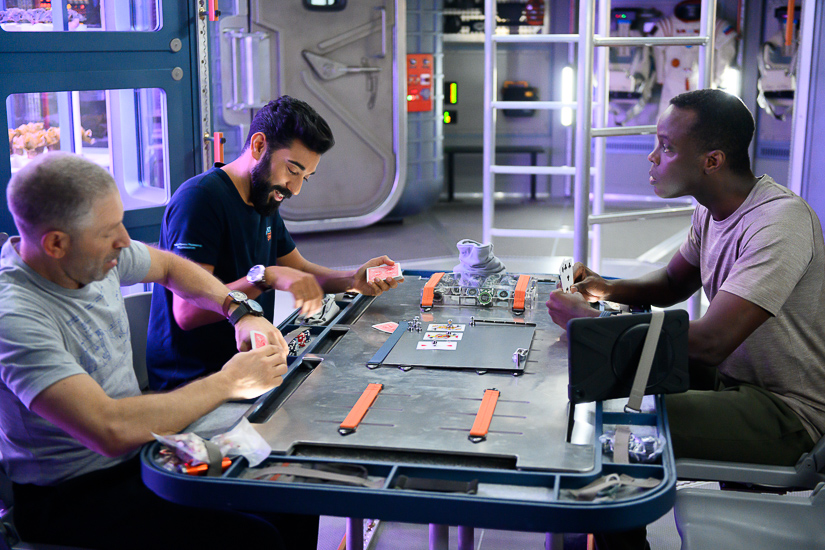
JG: The ship is a character and so it’s constantly reminding the audience that it is there even when the characters are just sitting around the table in the crew galley, conversing about whatever issues they are dealing with, either on their mission or back home.
They spend a lot of time in that setting and you are constantly reminded that the ship is ticking away in the background. There’s a tension and a peril to that because they’re in this tin can completely isolated from their families and they only have the resources that are on board with them (i.e., no help is coming). They are separated from 100%-guaranteed death by this cocoon they are in. So the tension that goes with their ship constantly ticking along reminds you subliminally that they are at the mercy of everything going the way it was planned and designed to.
Once you set up that baseline environment of this ship functioning in the background, you can add to it or take away from it when something goes wrong. These are little, subliminal shifts that people will hopefully not notice outright but will register on some level as they’re taking the story in.
They are separated from 100%-guaranteed death by this cocoon they are in.
To answer the other part of your question, about what makes our approach to space unique — you’ve got the two camps of Star Trek and the Star Wars. With the latter, more fantasy-based approach, you hear everything because it’s a ‘big action’ palette and you need all of those lasers and explosions to tell that story.
The other side is completely realistic. There is a complete and utter lack of sound in space because space is a vacuum. That’s not particularly exciting from a story point of view. The one show I can think of that did no sound at all out in space was Firefly, and I always respected them for that, but we didn’t want to go that way.
The showrunners on Away made some bold choices with music; there are long sections that don’t have music. And when we go outside the ship for the first time in Ep. 2, minutes go by before any score comes in. So it was down to us to use sound to tell the story of what’s going on with the ship. At that point, the solar panels were opening and they malfunctioned. We talked about making that completely realistic, where every time they go outside the ship we won’t have sound or music. You’d just be going off the visual. You could do that if you wanted to be realistic but it doesn’t really tell the story in a way that sound effects can do. So, we opted to do a filtered-off/effected version of sounds so you’re not hearing sounds like you’d be on Earth, but it’s more like you’re experiencing the sounds in a visceral way; you’re feeling the vibrations through the ship or you’re feeling the sound as the characters would while in the spacesuits.
…you’re feeling the sound as the characters would while in the spacesuits.
Like, when they connect their tether to the ship, they have this tactile interaction with the ship and the vibrations of that would be heard/felt through the suit. So the audience’s experience of a sound mirrors what the characters would be experiencing when outside the ship.
It wouldn’t be an exciting space drama without a few treks outside the ship! How did you create the sounds for the astronauts’ movements when they’re working outside the ship? They’re non-literal sounds, so was it more about effects selection and processing? Or did you record sounds in non-traditional ways?
GK: It was more about processing and effects selection. A lot of it was Foley, too. We have a great Foley team — Stefan Fraticelli and Ron Mellegers — who did this season for us.
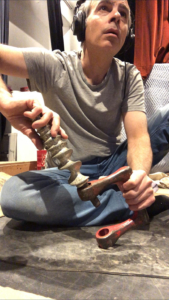
If you go technically real for the exterior sounds in space, it’s a vacuum and so you wouldn’t hear anything. So we went with the concept of sound waves traveling as vibrations through objects. Like, if you put your ear up to a railroad track you can hear a train coming from miles away because of the vibration. So, if an astronaut’s hand is latching a carabiner onto a hook attached to the ship, then the sound would theoretically travel through their body and you’d get a sense of it. So we did that by recording the actual sound and then processing it mostly with EQ. We were bridging the two worlds of reality and unreality, where you have the vacuum of space but the sound could conceivably travel through the body to give you a faint sense of that sound.
There are moments where you can go completely silent and it has a nice dramatic effect. But for action, with people doing things and trying to get from point A to point B, the silence just doesn’t work. We used this hybrid approach to give you a sense of danger or a sense of how they’re just attached to the ship by this little tiny thread.
JG: In terms of the execution, it’s a mix of post-processing and actual recording. For processing, we did extreme EQs with steep filter roll-offs and extreme low/mid boosts. For some of the Foley for the spacesuits, I was boosting 20 dB of 250 – 300 Hz just to get this extreme resonance of the tactile feeling.
In terms of recording techniques for some of the specific props, the original idea we had was to use contact microphones. So you put a contact microphone on the surface and recorded the sound through the surface. But that’s really hit and miss. It depends a lot on the surface and how well it transfers vibrations through it. If the surface is very rigid, you don’t tend to get very much sound coming through it. The sounds you end up recording are thin and wimpy sounding. So that didn’t work out too well.
For processing, we did extreme EQs with steep filter roll-offs and extreme low/mid boosts.
The Foley team came up with a more practical solution, which was to mic the Foley as they normally would but then add a small mic either inside or behind whatever they were interacting with. So I always had two mics on the Foley for the spacewalk stuff and I could mix and match between the two or use one or the other. Then, with that extreme EQ, I could create the effect I wanted.
GK: We used the dialogue and the breathing to the same effect. We used varying degrees of futzing (processing to simulate audio coming through a radio or transmission) rather than just one fixed amount. The amount of futzing was always changing, depending on what was happening dramatically.
We had the actors record more breathing, too, so we could use that as a device.
For instance, if the actors are just talking and there’s not much happening action-wise, we have minimal futzing. The voice is more full-bodied. As the actors move away from camera and more into danger, we may intensify the futz and make it sound more pinched and smaller — like it’s coming through a crummy speaker or smaller microphone — to create a bigger sense of distance between us and them. We varied the amount of futzing to create a feeling of intimacy or a feeling of danger.
We did the same with the breathing where, if they’re spacewalking along the ship then they might be breathing at a faster rate or slower rate depending on the amount of tension or relief we wanted the audience to feel.
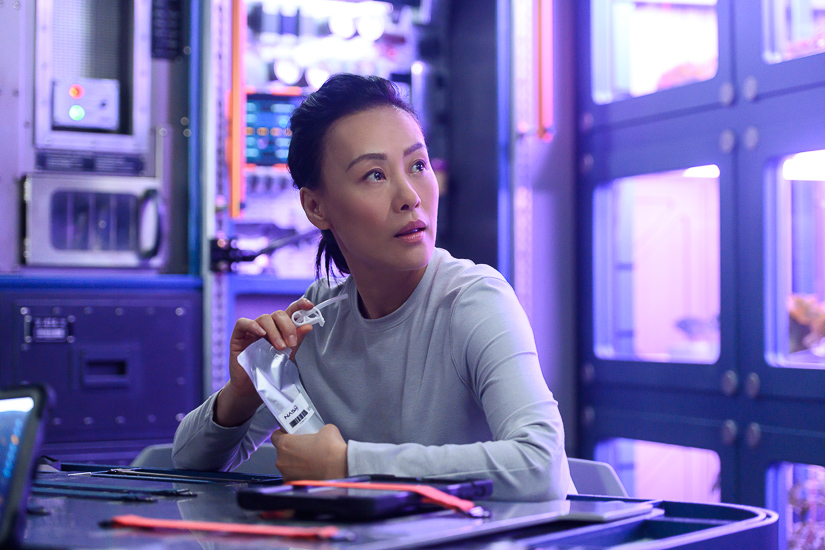
The ship’s interior is filled with buttons, knobs, switches, alarms… what went into creating this palette of ‘functional’ ship sounds?
JG: We had our in-house library which is very expansive. So between that and all the other libraries that are available these days, we have every kind of switch and lever imaginable already recorded!
GK: For the creation of the environment inside the walls, Jon (along with fellow King Soundworks sound designer Dan Gamache) created all of these servos and mechanical sounds, for the air ventilation system and the water system and navigational adjustment system. All those mechanical whirs and whines that we hear, Jon either recorded or pulled from our library, and then processed and layered and edited those to until they sounded like they were tech from the near future.
JG: The biggest thing for making the ship interior sound convincing was to make them sound like they were coming from behind the walls, behind panels and sheets of metal. There was a lot of treatment on all the ship sounds to make them sound like they weren’t right there in the room with the people but were deep in the bowels of the ship. A big part of selling it was having it sound like there were layers of equipment that surrounded them.
There was a lot of treatment on all the ship sounds to make them sound like they weren’t right there in the room…
There are a lot of tactile sounds — a lot of switches and knobs — and we didn’t want there to be a lot of beeps and touchscreens because that tends to have a very disconnected feel. Having things sound more mechanical and like they’re solid objects that are physically moving instead of just feedback that’s coming out of the speaker, that always sounds more grounded in the action. So we definitely wanted to embrace it.
GK: Another aspect was that lucky for us, Netflix wanted to deliver the show in Dolby Atmos. So we used that as part of the soundscape for the difference between Earth and being in the ship. We made a conscious decision very early on that while we’re in the capsule that’s when we’re going to use the Atmos surround field to its full advantage so that we feel like we are in the ship with the crew and surrounded by these walls with all these mechanisms in them. We were using every aspect of the Dolby Atmos field — the side surrounds and the ceiling. We used all of that.
Then when we cut to Earth, we narrowed the sound field so that everything comes off the screen. We use less surrounds and — with the exception of one or two occasions, like the PA announcements in the Mission Control center — we tried to keep everything out of the Atmos field.
By reserving the Atmos field for the space ship, you feel completely immersed in that environment. You feel like you are in the cocoon of that ship.
By reserving the Atmos field for the space ship, you feel completely immersed in that environment. You feel like you are in the cocoon of that ship.
On Earth, it felt less immersive. But we did as many “home touches” as we could. Wherever we could we added voices, which was easy to do in the command center at the NASA facility, but when we’re in their houses in the suburbs, we wanted to always make sure we heard birds, or dogs, or a lawnmower, or something that always hinted to this as life-as-normal. It’s life-like.
This created a contrast with the space capsule, where all of that ‘life’ disappeared. It made you feel isolated in the capsule, and far away from Earth. That was another thing we could use to our advantage.
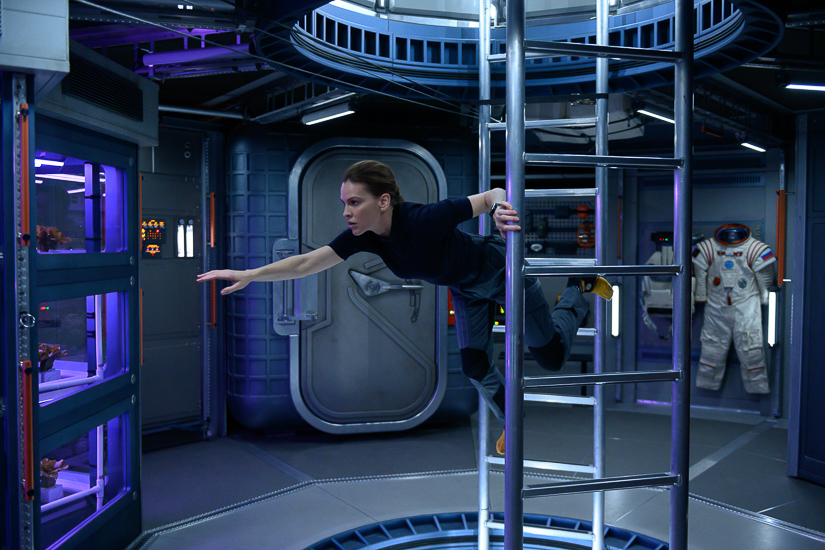
There’s a great episode called ‘A Little Faith’ in which the ship’s water system fails. You hear it groaning behind the ship’s walls. Can you tell me about your approach to that sound?
JG: That crisis extends into the next episode even. They’re in a situation where it’s entirely possible that they could run out of water at any minute if the system fully breaks. So the soundscape carries from one episode into the next, and it’s a constant reminder of the danger that they are in.
There are a lot of shudders and shakes as the different parts of the system drop out one by one.
It was fun to evolve that soundscape as the story arc develops. We set up the mechanics of the ship and had that behind the walls, inside another layer of the ship sounds. We took it a step further. What’s important is that it has to conceptually resonate to the viewer. It’s essentially the plumbing going bad and so it has to sound like plumbing. But it doesn’t have to sound like house plumbing. So, it has this resonant metallic feel to it. All the sounds we picked have a definite feeling of metal resonating and vibrating. There are a lot of shudders and shakes as the different parts of the system drop out one by one.
Also, the way we established the feel of the ship prior to that point, with it kind of ticking away in the background (there was a kind of rhythm to it), when the water system starts to fail it’s a lot more violent and becomes much more to the forefront. Things kind of jump out of nowhere.
There isn’t as much rhythm to it. It’s more jarring. It puts you off your balance and on your back foot and you’re worried about it.
[tweet_box]Aiding ‘Away’s Story With Sound[/tweet_box]
What was in your processing chain to make it feel like the sounds were coming from inside the ship’s walls?
JG: It’s mostly made out of convolution reverbs taken from inside metal containers. It may be an impulse response taken from inside a small pipe, all the way up to large metal structures.
There are a couple of impulse responses in Audio Ease’s Altiverb that I used a lot, and those were captured inside a water tower and another was inside a giant metal pipe used to house fiber optic cables that they lay across the ocean floor. Someone at Audio Ease I believe went inside one of these giant cylinders and recorded an IR to capture what that environment sounds like. That was really cool to use, to give a sense of being encased in metal.
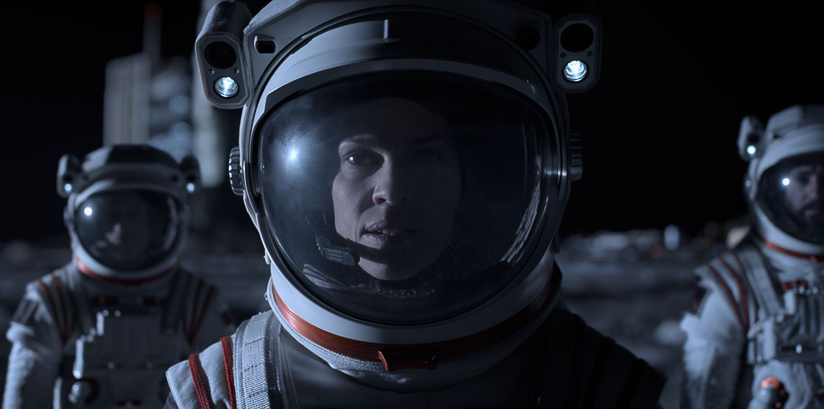

JG: Yes, there is an atmosphere on Mars. And I looked up what kind of atmosphere Mars has and how that would affect the sound just to get a baseline for what reality would be. I found out that the atmosphere on Mars would make things sound thinner, less bassy, and the sound wouldn’t travel as far. Depending on where the story goes, that is something that we could potentially have more fun with.
The idea for the atmosphere that we built for the end of Ep. 10 was based off that idea that when they are outside the ship while it’s in space, everything sounds boomy, thick, and thuddy. In contrast, when they get to Mars, everything is thinner and wispier. It’s nice to have those two play off of each other in that way.
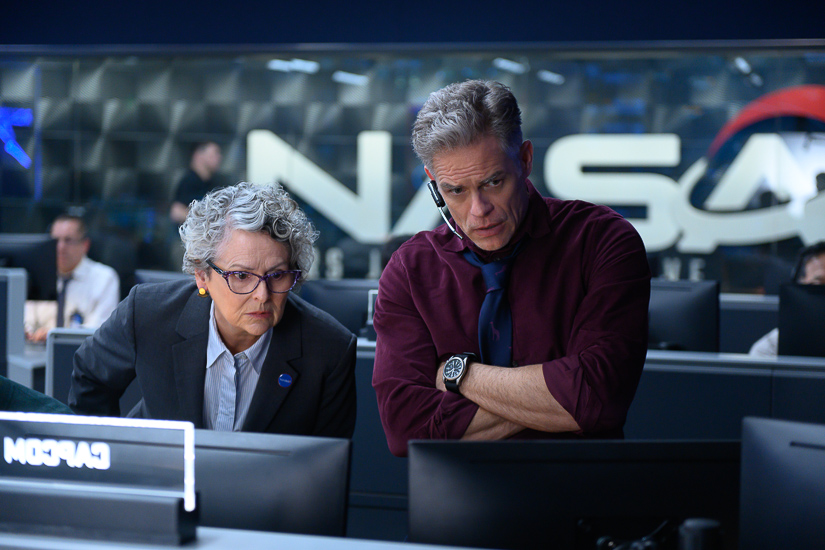
How did you use sound to help intensify the experience of landing on Mars?
GK: We wanted to make that as scary as humanly possible. No one has ever landed on Mars before. The broad stroke of that sequence was to make it sound like at any second that capsule was going to get ripped apart and the crew wasn’t out of danger until they touched down. That was the overall concept, that they’re not safe until they’re safe. They could shred at any possible second.
It cuts back and forth between these tense moments and these tender moments…
JG: The cool thing about the way the sequence is constructed is that it’s cutting back and forth between the families back at Mission Control listening to what could potentially be the final messages from the astronauts that they would ever hear and the astronauts themselves landing on Mars. It cuts back and forth between these tense moments and these tender moments of the children and husbands and wives taking in these messages from the crew.
Highlights from A Sound Effect - article continues below:
The landing builds and builds to this crescendo of rattling panels on the outside of the ship and a few panels fly off, which we had a lot of fun with in the Atmos format. There is fire and pieces of metal flying around and overhead as they burn through the atmosphere as the sequence progresses. That was definitely one of the most fun sequences to put together and then mix as well.

Because this isn’t a theatrical release (it’s streaming for TV), were you limited to ‘broadcast spec’ or were you able to really use the LFE channel to add sufficient low-end to make the audience feel compressed like they’re feeling the G-forces as the shuttle was landing?
JG: We had to conform to a certain spec, but Netflix’s spec is ‘better’ than broadcast. I prefer mixing to their spec because it’s well-considered in terms of where they want the dialogue to sit with respect to the maximum peak-level. The dialogue level is a little bit lower than what would be ‘broadcast spec’ and that allowed us a little more headroom so we were able to get a little louder in the moments where we wanted to get more intense.
Then, of course, people are going to watch it in stereo. There will be people out there watching it on their AirPods or tablets or whatever and so we had to mix for that too. When you’re listening to the Atmos version of the mix, it’s huge and there is stuff flying everywhere but then we definitely wanted to make sure that if someone is listening to it on their Chromebook speakers that they don’t lose that sense of danger. It’s a difficult balance to make but it’s one that we were definitely very conscious of. We wanted to straddle that line so that no one missed out on that experience no matter how they were watching the show.
GK: We always do multiple mix passes on small stereo speakers at a lower volume so that we can make sure that all the things we want to get across emotionally, sound-wise, translate over to the small speakers. We always do a pass on that so that if you are watching on a tablet or even a TV with stereo speakers, you’re going to get as much as you can possibly get out of it. We’re not just mixing for the best possible scenario and format and hope that people at home have a huge home theater system. We’re extremely conscious that a very large number of people will be listening to this on smaller speakers. We want to make sure they get the same enjoyment out of it. So we do multiple passes where we turn the Atmos speakers off and monitor the mix so we can make adjustments for these tiny speakers at a low volume, so that we know people can hear it at home on their TVs the way that we intended.

